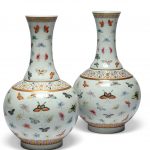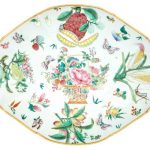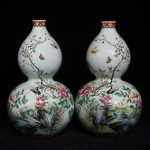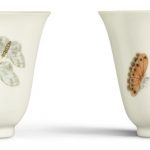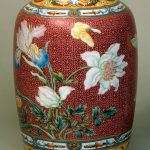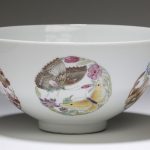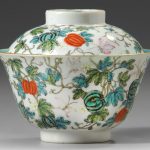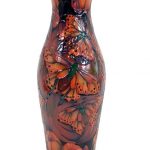The term famille rose refers to the color palettes used in Chinese porcelain. Famille rose was introduced late in the reign of the Kangxi Emperor (1661–1722), possibly around 1720. It used mainly pink or purple and remained popular throughout the 18th and the 19th centuries, also being widely adopted by European factories. Famille rose enamel ware allows a greater range of colour and tone than was previously possible, enabling the depiction of more complex images, including flowers, figures and insects. Reference: Wikipedia.
Below are some examples, information and price guides to famille rose antiques which include butterflies in their design, including a pair of butterfly bottle vases and a pair of butterfly cups.
A PAIR OF FAMILLE ROSE BUTTERFLY BOTTLE VASES GUANGXU SIX-CHARACTER MARKS IN IRON-RED AND OF THE PERIOD (1875-1908) Each vase is decorated to the globular body and neck in bright enamels and gilt with a colourful multitude of butterflies with a gilt-bordered band of alternating lotus and shou characters to the shoulders. Further bands of ruyi heads and lappets encircle the mouth rim and the base. 15 ½ in. (39.5 cm.) high
Sold for GBP 18,750 at Christie’s in 2019
Chinese Famille Rose Enamel-Decorated and Parcel-Gilt Porcelain Footed Dish First half 19th century Of shaped form, decorated with ears of corn, fruit, plants, flowers, butterflies and insects and centered by a basket of flowers, on a shaped foot. Height 4 inches (10.2 cm), width 15 1/2 inches (30.4 cm).
Sold for $1,125 (includes buyer’s premium) at Doyle in 2020
YONGZHENG MARK FAMILLE ROSE FLOWERS AND BUTTERFLIES
Qianlong Period 18 Century / Height 10.43 in / Diameter 5.91 in
Sold for $8,500 at Cardale Auctioneers in 2020
A PAIR OF FAMILLE-ROSE ‘BUTTERFLY’ CUPS
DAOGUANG SEAL MARKS AND PERIOD each with an inverted bell-shaped body rising from a short foot to a flared rim, brightly enamelled with fruiting pomegranate branches and three fluttering butterflies, the base with a six-character seal mark in iron-red
Diameter 7.5 and 7.5 cm, 3 and 3 in.
Sold for 40,000 GBP at Sotheby’s in 2019
Vase of porcelain painted with enamels, 1736-1795, Qianlong period, Chinese
The sumptuous style of this vase is replicated on pieces in both the Beijing and Taiwan Palace collections, and would appear to have found favour at court in Qianlong’s reign (1736-1795). The detailed and naturalistic painting of flowers and butterflies is set against a thick ruby-red enamel, while the jewel-like borders around the neck and above the foot are highlighted to simulate shining gems, with touches of gilding. The decoration suggests the influence of enamel-painted copper, manufactured in the palace enamelling workshop until 1789.
The main ground is enamelled in purplish-crimson with a scratched lattice pattern and against this are set finely-painted iris and other flowers in ‘famille rose’ colours. the formal colours above and below are on a ground of yellow. A pale turquoise enamel appears inside the lip and on the base. This style of decoration, described as ‘on a graviata ground’ in early 20th century English art books, are referred to as ‘ci tai yang cai jin shang tian hua’ in palace records. They were made between 1741 and 1743.
Reference: Victoria and Albert Museum
Bowl with Flowers and Butterflies Flowers and butterflies located within medallions adorn the exterior of this “famille rose” bowl.
Circa 1723-1735
Reference: The Walters Art Museum

